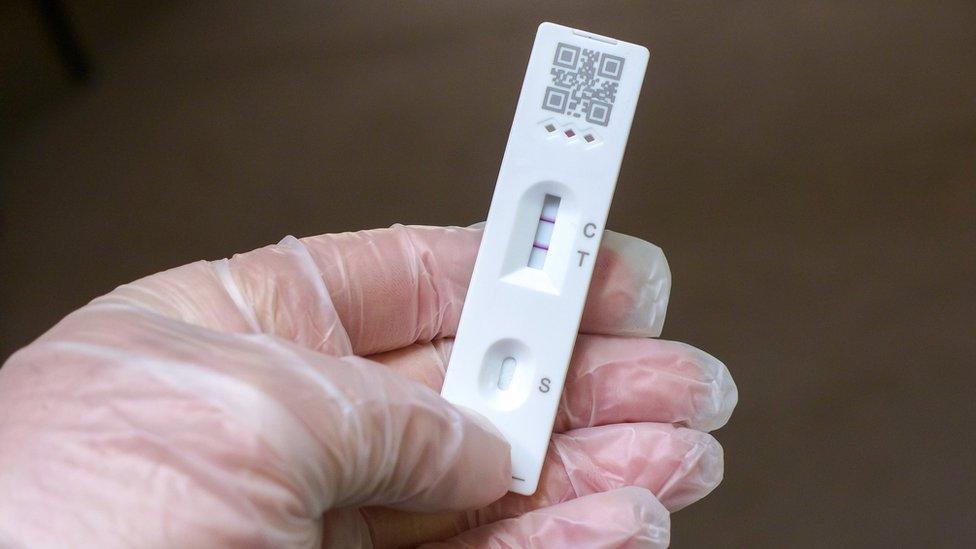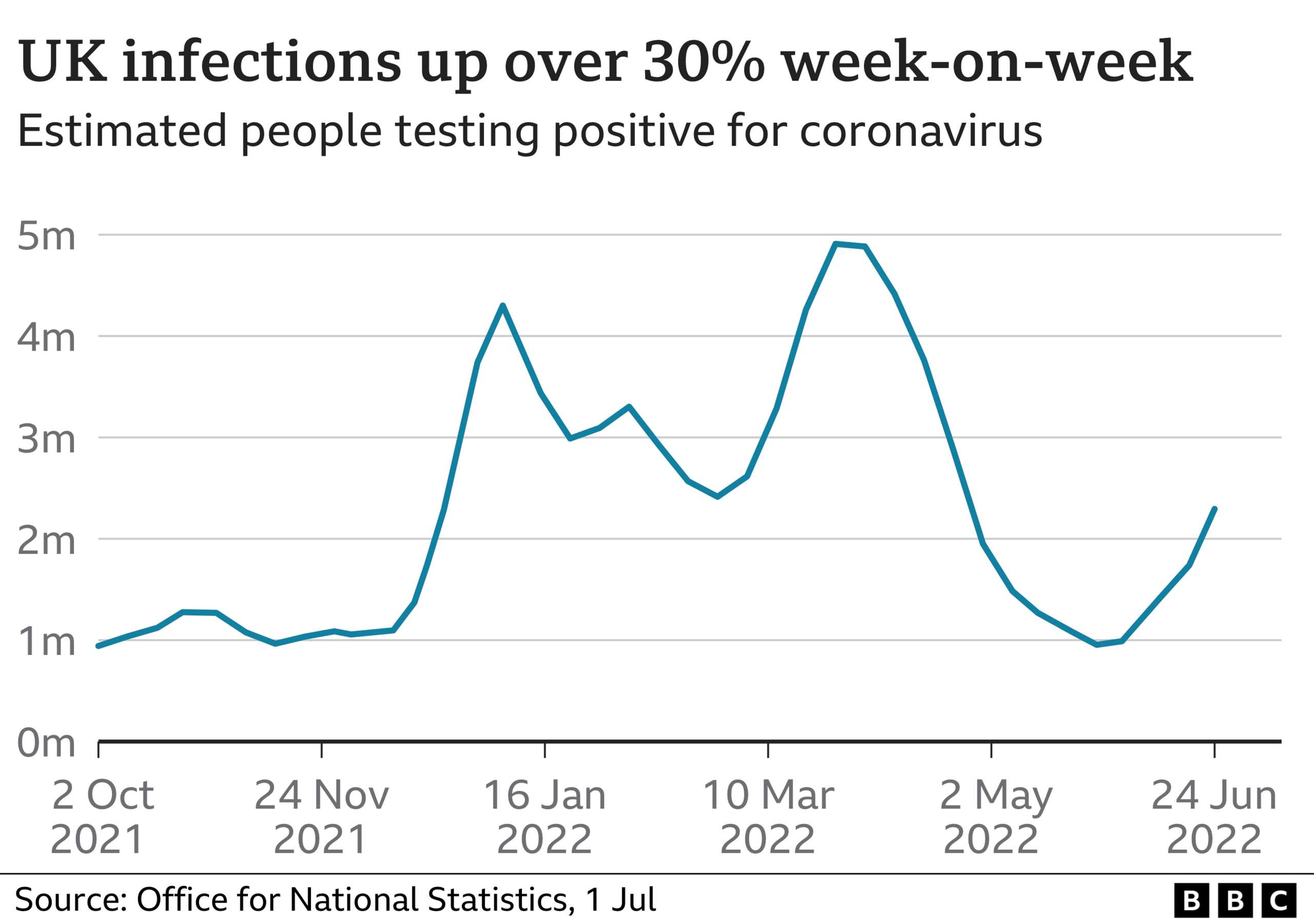Covid is rising again in the UK - should we worry?
- Published

You'd be forgiven for letting out a weary sigh. There's so much going on from Ukraine to the rising cost of everything - and now Covid is rearing its ugly head again.
The latest statistics show the number of people infected in the UK has more than doubled since the start of June with around 2.3 million people testing positive. You probably know someone who's had it.
So is summer ruined? Two-and-a-half years into the pandemic we're back facing new variants, a surge in infections, questions about whether the NHS can cope and what it means for all our lives. It's also giving us a clearer idea of what living with Covid is going to look like.
"We're in a bad patch at the moment," says professor of public health at the University of Edinburgh Linda Bauld.
"It's very disruptive to society and some are suffering severe effects, but that's still a tiny proportion of where we were."

The driving force behind the sudden surge in infections is the double act of BA.4 and BA.5. These two mutated forms of the virus are technically sub-variants of Omicron. The original Omicron had an impressive ability to spread and overcome the immune defences our bodies have built up to keep the virus out. BA.4 and BA.5 are even better. Their ascent started before big summer events like the Jubilee celebrations or Glastonbury so it's not like we've just partied our way into a new wave.
Prof Danny Altmann, an immunologist at Imperial College London, says it's "shocking" how much the virus is able to change to keep on infecting us. He recalls seeing the first scientific analysis of Omicron last winter: "I felt like I'd just seen the worst horror film on the planet and yet it keeps throwing up worse ones".
The result is we're now entering another - arguably our third - Omicron wave of the year and it's only just July.
Slippery virus
Research in the New England Journal of Medicine, external showed BA.4 and BA.5 can "substantially escape" the protection from either vaccination or infection. A study in Science, external also showed the original Omicron was like a "stealth virus" that left limited protection if you came across Omicron again.
The new sub-variants' slippery skills combined with our waning immunity means stories of catching Covid multiple times are now increasingly common. Plus there's still a surprising number - one-in-five of us, external - who have somehow dodged Covid throughout the pandemic.
"[This virus] continues to surprise us in unpleasant ways, you would have hoped there would be more protection from one Omicron variant to another" says Prof Mark Woolhouse, who studies disease outbreaks at the University of Edinburgh.
However, the most important form of protection - against becoming severely ill, ending up in hospital and dying - is clearly holding up. If there were 2.3 million cases in the era before vaccines then the NHS would be swamped and tens of thousands of people would die. That is clearly not happening.

The upswing in Covid cases started before the Jubilee celebrations
But even with that protection BA.4 and BA.5 still have the potential to leave you feeling seriously rough.
"I think it's far from a bad cold," says Prof Susan Hopkins, from the UK Health Security Agency, who says people are "ill for between seven and 10 days".
That has knock-on effects if you need to work - staff sickness in the NHS is another way the virus can pile pressure on the health service - or were planning to go on a nice holiday.
"What do you do if your school has no teachers or an airline has no pilots? How do you suck that up?" asks Prof Altmann.
Rising cases will also have a disproportionate effect on the clinically vulnerable, external and leave behind cases of long Covid.
Severity question
There are no signs this virus is any more or less dangerous that original Omicron, but we don't know for sure.
So far there is only laboratory and animal research. A study in Japan, external shows BA.4 and BA.5 can grow more readily in lung cells. Hamsters had worse disease than with earlier forms of Covid.
The UKHSA has reported, external a "small" increase in the proportion of those infected needing hospital treatment since April. But the reason is unclear and could include waning vaccine protection or a shift in who is catching the virus.
Prof Woolhouse, who was one of the scientists to show original Omicron was milder, says "we haven't seen definitive data" on BA.4 or BA.5 because we're not collecting the same volume of information now.
However, variants don't have to be worse for it to impact the NHS - they just have to infect enough people. Then the small proportion who do get into trouble still add up to a big number.
The number of people in hospital with Covid across the UK is 10,081 - up by around 2,500 in a week. More than half of those will be there for other reasons, such as a broken bone or a stroke, but they still need to be managed.

"I remain concerned, one more doubling [in numbers] brings the NHS into significant challenge," says Prof Hopkins, the chief medical advisor at the UK Health Security Agency.
The hope will be that the UK follows a similar trajectory to countries like South Africa and also Portugal.
Prof Bauld: "I think we should be optimistic, in those countries that are ahead of us, things are settling down, these things do burn themselves out as they run out of people to infect."
However, it looks as though the idea that Covid will just become a winter bug is either wrong or someway off.
"Every year we say this and then it causes a wave in the summer, driven by new variants coming along more than once a year," warns Prof Woolhouse.
The virus may be looking more flu-like in terms of severity, but the difference at the moment is flu comes only once a year.
There is no political appetite to return to any restrictions. The big decision is going to be around the vaccination programme ahead of next winter - who gets vaccinated and equally importantly with what?
Both Pfizer, external and Moderna, external have announced updated vaccines that target the original Omicron, but that is already yesterday's variant.
Follow James on Twitter., external
